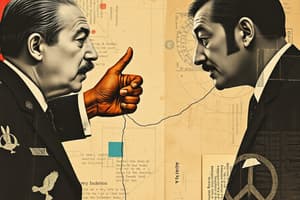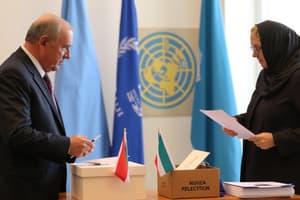Podcast
Questions and Answers
Which scenario best exemplifies the World Health Organization's definition of violence?
Which scenario best exemplifies the World Health Organization's definition of violence?
- A company knowingly releasing pollutants into a river, causing harm to the local ecosystem. (correct)
- A government implementing strict economic policies that unintentionally lead to increased poverty.
- A country engaging in diplomatic negotiations to resolve a trade dispute.
- A person accidentally causing injury to another while playing a sport.
A ceasefire is most effective when it:
A ceasefire is most effective when it:
- Immediately resolves all underlying political disputes.
- Is accompanied by efforts toward long-term conflict resolution. (correct)
- Is used as a tactic to re-arm and prepare for further conflict.
- Guarantees complete trust and transparency between warring parties.
In what way does citizen diplomacy primarily contribute to the peacemaking process?
In what way does citizen diplomacy primarily contribute to the peacemaking process?
- By negotiating and signing legally binding peace accords.
- By initiating dialogue and creating a foundation for formal negotiations. (correct)
- By acting as a substitute for official diplomatic channels.
- By enforcing peace agreements through non-violent interventions.
How does peace enforcement differ from peacemaking?
How does peace enforcement differ from peacemaking?
Which of the following scenarios would most likely require peace enforcement rather than just peacemaking?
Which of the following scenarios would most likely require peace enforcement rather than just peacemaking?
Which of the following scenarios best exemplifies the 'isolation of a particular party' objective in a conflict resolution operation?
Which of the following scenarios best exemplifies the 'isolation of a particular party' objective in a conflict resolution operation?
A nation recovering from civil war is attempting to rebuild its economy, reform its justice system, and foster political reconciliation. Which of the following approaches would best represent 'positive peace' in this context?
A nation recovering from civil war is attempting to rebuild its economy, reform its justice system, and foster political reconciliation. Which of the following approaches would best represent 'positive peace' in this context?
A conflict has erupted between two ethnic groups within a country. International mediators are brought in to facilitate a dialogue. Which action would be most aligned with the principles of 'peace mediation'?
A conflict has erupted between two ethnic groups within a country. International mediators are brought in to facilitate a dialogue. Which action would be most aligned with the principles of 'peace mediation'?
In a post-conflict setting, a UN peacekeeping mission is deployed to maintain order and support the transition to a stable government. Which activity would be considered outside the scope of 'peacekeeping'?
In a post-conflict setting, a UN peacekeeping mission is deployed to maintain order and support the transition to a stable government. Which activity would be considered outside the scope of 'peacekeeping'?
A region has experienced prolonged conflict, leading to widespread displacement, economic collapse, and social fragmentation. Which of the following strategies would most effectively integrate 'peacebuilding' and 'peacekeeping' efforts?
A region has experienced prolonged conflict, leading to widespread displacement, economic collapse, and social fragmentation. Which of the following strategies would most effectively integrate 'peacebuilding' and 'peacekeeping' efforts?
Flashcards
Forcible Compliance
Forcible Compliance
Ensuring ceasefires are obeyed by force.
Buffer Zones
Buffer Zones
Establishing zones to keep opposing forces apart.
Peacebuilding
Peacebuilding
Restoring stability after conflict, building justice and freedom.
Peace Mediation
Peace Mediation
Signup and view all the flashcards
Peacekeeping
Peacekeeping
Signup and view all the flashcards
Violence
Violence
Signup and view all the flashcards
Ceasefire
Ceasefire
Signup and view all the flashcards
Peacemaking
Peacemaking
Signup and view all the flashcards
Peace Enforcement
Peace Enforcement
Signup and view all the flashcards
Study Notes
- Violence is the premeditated use of physical force or power, threatened or actual, against oneself, another person, or against a group or community.
- Violence can result in or has a high likelihood of resulting in injury, death, psychological harm, or dispossession.
- Anything done in a deleterious or damaging way may be termed violent even if not meant to be violence.
Ceasefire
- A ceasefire is a bilateral or multilateral pause in all aggressive military actions among parties involved in war, guerrilla warfare, or violent exchanges.
- Ceasefires sometimes lead to steady or long-lasting military or political settlements.
- Ceasefires target the reduction of tensions and life-threatening damages while providing encouragement for other practices of conflict resolution.
Peacemaking
- Peacemaking involves building a settlement between disputing parties through dialogues or with a third-party mediator.
- Mediators assist with process and communication problems and help parties draft a workable peace accord.
- Negotiators are typically official diplomats, though citizens are increasingly involved.
- Citizen diplomacy is a common way to start the peacemaking process, which is finalized with official diplomatic efforts.
Peace Enforcement
- Peace enforcement involves operations to end military or violent exchanges or acts of aggression, with or without the consent of parties to the conflict.
- It creates a permanent and viable environment.
- It is associated with the employment of military forces to generate 'negative peace' (the absence of violent conflict engagement).
Peace Enforcement Objectives
- Enforcing compliance of ceasefires
- Separating belligerents
- Isolating a particular party or parties to the conflict
- Establishing buffer zones or safe havens
- Decommissioning of arms and demobilization of combatants
- Protecting human rights
- Assisting with humanitarian aid
Peacebuilding
- Peacebuilding is made up of policies, programs, and associated efforts to restore stability and the effectiveness of social, political, and economic institutions and structures in the wake of debilitating events.
- Peacebuilding aims to create conditions for 'negative peace' and 'positive peace', comprehensive understanding related to the institutionalization of justice and freedom.
Peace Mediation
- Peace mediation is defined as a voluntary process whereby a third party assists two or more parties, with their consent, to prevent, manage, or resolve a conflict by helping them to develop mutually acceptable agreements. (UN Guidance for Effective Mediation, 2012)
- Mediation support refers to the professional (e.g. methodological, operative) support of mediators or teams of mediators and parties to a conflict in mediative conciliation processes
Peacekeeping
- Peacekeeping is the maintenance of public security, civil services, and ceasefire agreements in war and conflict zones by UN or regional military, police, and civilian forces with the consent of the nation-state on whose territory these forces are deployed.
- Its purpose is to ensure stability and relative normalcy in the aftermath of volatile situations, with the extended goal to create conditions conducive to establishing lasting political settlements.
Studying That Suits You
Use AI to generate personalized quizzes and flashcards to suit your learning preferences.




